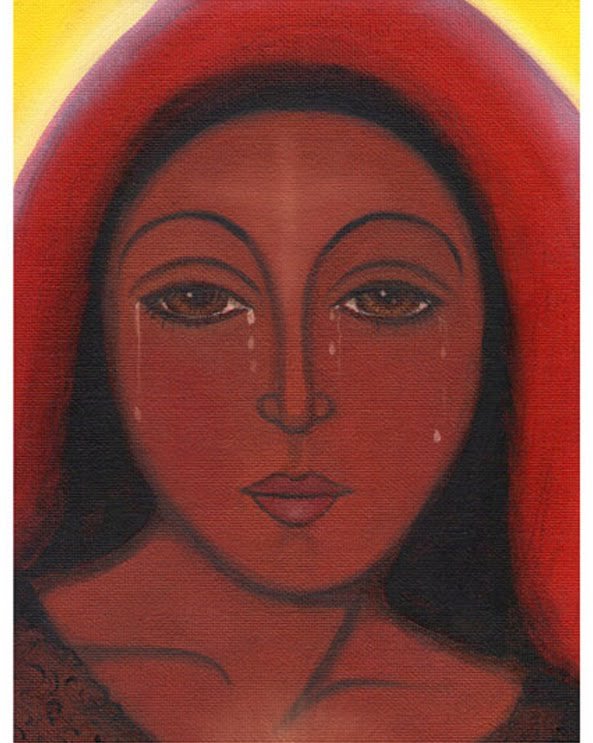Song of the Magdalene: Mary Magdalene of the Tears
Song of the Magdalene: Mary Magdalene of the Tears
 Mary Magdalene of the Tears, Oil on canvas board, 7" x 9", 2010
Mary Magdalene of the Tears, Oil on canvas board, 7" x 9", 2010
Beloved disciple,
your tears arrived,
when you embraced,
your vision,
weaving the warp and weft,
where we now rest,
in the perpetual lace
of Resurrection.
(Verses from the poem Tears of Freedom)
In Spanish, there is a very popular expression: "Crying like a Magdalene." I don't know if the same is true for other languages and cultures, but for Puerto Ricans, the Magdalene is always the image of crying in desperation. This Magdalene, the last one I completed (for now!), is the only one I painted with tears as an iconographical reference. But once again, I am substituting the traditional meaning and offering a new interpretation. In this painting the tears are not a reference to pain, but to freedom.
Mary Magdalene must have experienced an immense amount of pain. She chose to face it. She stayed by the Cross as her Beloved died a terrible death. She did not run away before or after, but lived through it. Those of us who know pain of any kind, physical or emotional, know that once we live through it, something happens. Nothing is the same as it was before, there is a calm, a silence of a meditative and clear nature. A silence that lets us hear its lesson.
Pain is a great teacher. Once we meet pain, we will forever be aware of the suffering of others. What we could not imagine possible in terms of suffering, we realize as true after knowing pain. Empathy and compassion can blossom out of this experience, and a new kind of strength as well. It is as if pain can have the power weaken our bodies, while also containing the possibility of adding muscle to our souls.
I, like many people, have experienced both physical and emotional pain. The physical pain of cancer is excruciating. It creates an impenetrable layer of fear that can soon make you wish death. It is clear and loud, like a bomb. Emotional pain can be the opposite. It is so quiet and ineffable that we can't notice it as it takes over our life and then crawls all over us like a slimy snail. Both can take us into the most immense loneliness, and both can kill us, or liberate us.
Why can pain liberate us? Because when we face it, we make the decision to be free. Even if we cannot get rid of the pain, we can be free to start finding a new way to live, a new way to see. There are terrible things in the world, and I cannot console or offer any words of comfort to the victims of all the terrible errors of humanity, or to the victims of illness or even of pure chance. All I can say, from my very limited perspective, is that when people embrace their experience of pain, they make a difference in the lives of those who are just beginning to live it, and as a result, their own lives acquire purpose. Of all the things I read about cancer during the moments when I first had to face it, only the stories of survivors stayed with me. That was all I had, and that was all I held on to. The Magdalene had more than I did at the time. She had her faith in the Resurrection.
Whether we understand the Resurrection as a literal or interpretative event, faith remains the base of its redeeming power. Faith is the notion that we can be reborn out of a life-changing experience. Mary Magdalene was reborn through her tears of pain, the same tears that brought her liberation from being a woman to being a human being in its full expression. Her tears formed the veil she penetrated in order to see the true nature of her teacher, and in order to see her own true nature. It was through her faith in her vision of the Resurrection that she brought the news to the world that we were more than just our flesh, that we were beyond sin. If we accepted the redeeming nature of death and rebirth, we would be born into a new being free from the archaic notion of sin, free from judgement, free from the restraints we had invented in response to fear. She brought faith in answer to fear, rebirth in answer to death.
So from now on, when we go to a museum or a church and see a crying Magdalene, we can choose to remember that the purpose of the Crucifixion was the Resurrection, and that the tears we see washed her eyes of the illusion of death in order to see life. Her vision, of life reborn, of life never dead, can be the warp and weft on which we can place our faith to believe that out of our pain, a new life can be born.
***
Tanya Torres
Prayerfully painting for more love, for more peace, for more faith, for our world to be reborn. http://www.tanyatorres.com


 Votes : 0
Votes : 0









